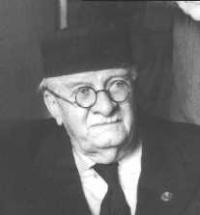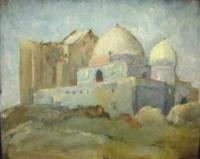You are here
Archaeologist Masson.


Photo tours in the mountains of Uzbekistan.
«Memory is the treasure house of the mind wherein the monuments thereof are kept and preserved»
Thomas Fuller.
Photo walks around Uzbekistan.
At the end of last year, the centenary of the birth of Mikhail Evgenievich Masson, professor, doctor of historical and archaeological sciences, academician of the Academy of Sciences of Turkmenistan, an outstanding archaeologist, was celebrated.
He was born on December 5, 1897 in Samarkand. While still a high school student, he was fascinated by the beauty of this extraordinary city, where everything - from the harsh settlement of Afrasiab to the beautiful monuments of the Registan - was saturated with the aroma of past centuries.
As a teenager, he participated in the excavations of a local archeology enthusiast V.L. Vyatkina, conducted on Afrasiab, in particular, on the opening of the remains of the unique Observatory of Ulugbek of the XV century. By the way, now a small street, named after academician M.Ye. Masson.
In 1916 he began his studies at the Petrograd Polytechnic Institute, intending to become an irrigation engineer. But fate decided otherwise: there was a call for military service and participation in events on the South-Western Front, where he was elected a member of the Council of Workers 'and Soldiers' Deputies.
In 1918, M.E. Masson returned to Samarkand. Immediately he became involved in matters related to the study, protection and restoration of monuments of Samarkand. Soon he was appointed head of the Samarkand regional museum, whose collection thanks to the activities of M.Ye. Masson was enriched with various exhibits: from the magnificent panels of the Samanid palace, excavated in Afrasiab, to the collection of beetles found in the Samarkand region.
In 1924, M.E. Masson was transferred to Tashkent to work in the Turkestan (later Uzbek) Committee for the Affairs of Museums and the Preservation of Monuments of Antiquities and Art as the head of the archaeological department of the Main Central Asian Museum.
At the same time, he attended courses at the Turkestan Oriental Institute, and also carried out exploration and excavation work, in particular, conducted archaeological observations on the restoration of monuments and carried out the work of an instructor for museum affairs in the republics of Central Asia.
From 1929 to 1936, Mikhail Evgenievich studied the history of mining at the Geological Committee, where he created an excellent geological library, combining work with the head of the archaeological sector of the Uzbek Committee for museums and the preservation of ancient monuments and art.
During these years, he prepared a number of works on the history of mining in Central Asia during the Middle Ages on the basis of trips and observations of the excavations of ancient mine workings and their projection onto the data of the original sources of the Xth - XVth centuries.
Since 1936, M.E. Masson - Head of the Department of Archeology at the Central Asian (later - Tashkent) State University. Here, the breadth of his knowledge and organizational skills were manifested with particular force.
Here he created a school of archeology, the graduates of which later became leading archaeologists of Central Asia. The distinctive feature of the nature of ME Masson - dedication to the cause to which he served, be it geological prospecting in little-known areas of Central Asia, excavation of a vast settlement, a single grave, or a speech at a conference.
M.E. Masson was a versatile scientist. The combination of deep knowledge of primary sources, knowledge of classical Eastern and European languages with a variety of archaeological methods determine the persuasiveness of his final historical conclusions.
His works raised questions of history and culture, the economy of bygone eras, the historical topography of cities and abandoned settlements, the history of mining and crafts, architectural heritage and others. At the same time, he was not a closed, armchair scientist, but an active organizer of science.
The Department of Archeology under the Tashkent State University headed by him, which he supervised before retiring, not only provided the history department with a course in general archeology, but here he and his staff read a number of special courses - from Central Asian archeology to Oriental art.
Mandatory for students, he made annual participation in archaeological expeditions, so that by the time they graduated from the university they could already conduct independent archaeological excavations. M.E. Masson conducted work throughout Central Asia, including in Kazakhstan.
In 1927, he studied Taraz and Sairam, two years later - the Khoja Ahmed Yasawi mausoleum in Turkestan, about which he later wrote a small book. They were advised by some museums about a number of finds in Kazakhstan, in particular, from a burial ground in the Nura river basin and, especially, about kurgan burials of the XIII - XV centuries. He also participated in the study of a number of monuments in Kyrgyzstan.
So, in 1945 we carried out a joint study of Gumbez Manas, one of their masterpieces of the 14th century Central Asian architecture. In the 1920s, being an instructor in museum affairs on a Central Asian scale, he was one of the founders of a museum in Shymkent, which is still one of the cultural centers of the city.
But the main objects of his work were concentrated in Uzbekistan and Turkmenistan. In the 1920s these were only initial reconnaissance, and from the 1930s large, long-term expeditions. These are TAKE - Termez archeological complex expedition (1936 - 1938), expedition of archaeological supervision on the construction of the Great Fergana Canal (1936), STACE - South Turkmen archeological complex expedition (1946 - 1968), KATE - Keshskaya archaeological expedition (since 1963).
The abbreviation draws attention to the letter "K" - complex. M.E. Masson gave this concept a great meaning, bearing in mind that not only archaeologists should take part in archaeological work, but also specialists of other profiles - architects, biologists, geologists, who, helping an archaeologist, solve the history of architecture, technology of various kinds of production, and so on.
For me, for example, participation in TAKE and STAGE has opened up the possibility of directly studying architectural monuments (up to one and a half hundred objects, mostly not previously studied), their measurement, descriptions, comparative analysis and identification of the main processes of architecture development in the studied regions.
The result of the work of complex expeditions organized and headed by M.Ye. Masson, were the publication of materials, carried out under his editorship. Only in the line of STACE, 23 volumes of "STAGE Materials" were published, not counting articles.
On the basis of participation in large expeditions, students prepared diploma theses, and research associates prepared dissertations. I would like to add that the composition of the expedition members was international - they included representatives of the Central Asian republics, Russia, the Caucasus. Here archeologists Kh. Alyspaev and M.
Mershchiev, who later worked in Kazakhstan, were formed. Among the participants in the works led by Masson are current academicians and corresponding members of the CIS Academies of Sciences. 100-year birthday of ME Masson was marked by meetings in Tashkent, Ashgabat, and the annual Masson readings held in Tashkent.
He left a good memory of himself as a scientist who gave all his strength to science, to its future.
Enlightener:
G. Pugachenkova. Kumbez, 1998, №1 http://old.unesco.kz







